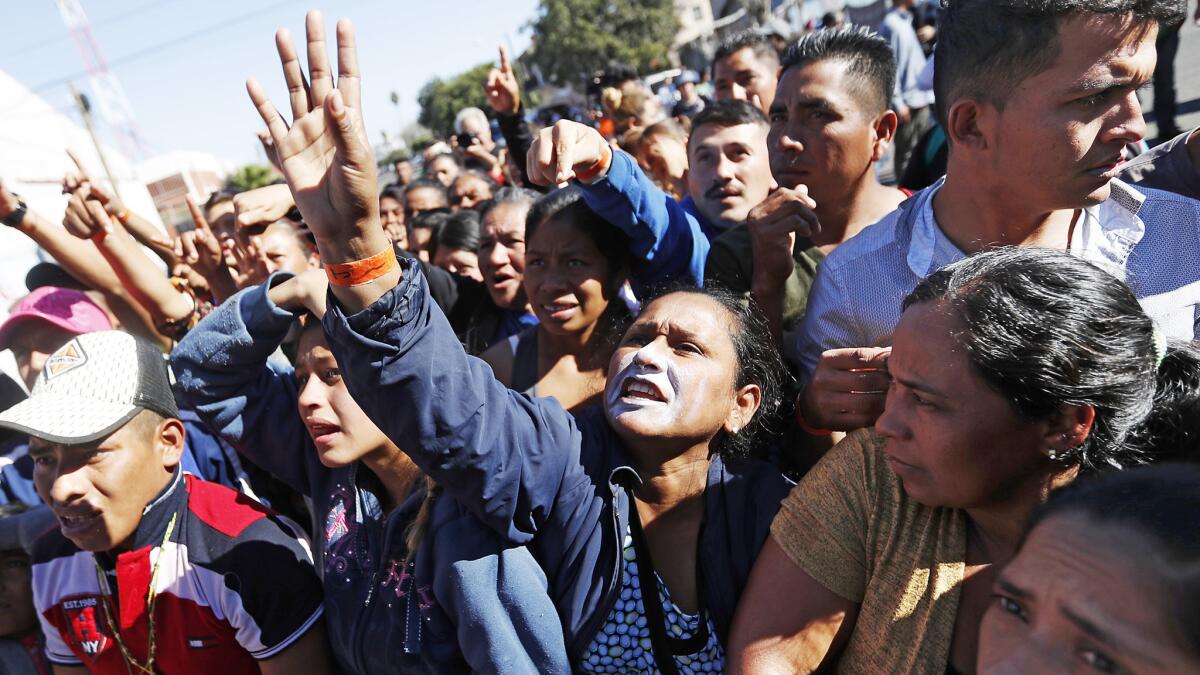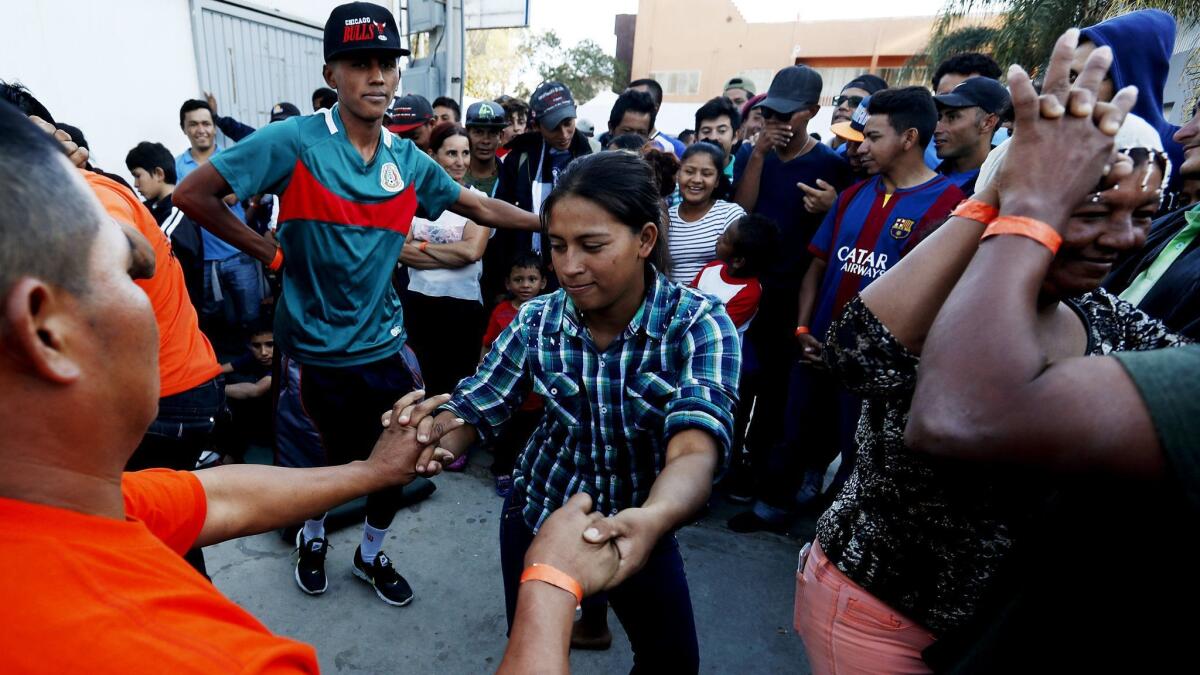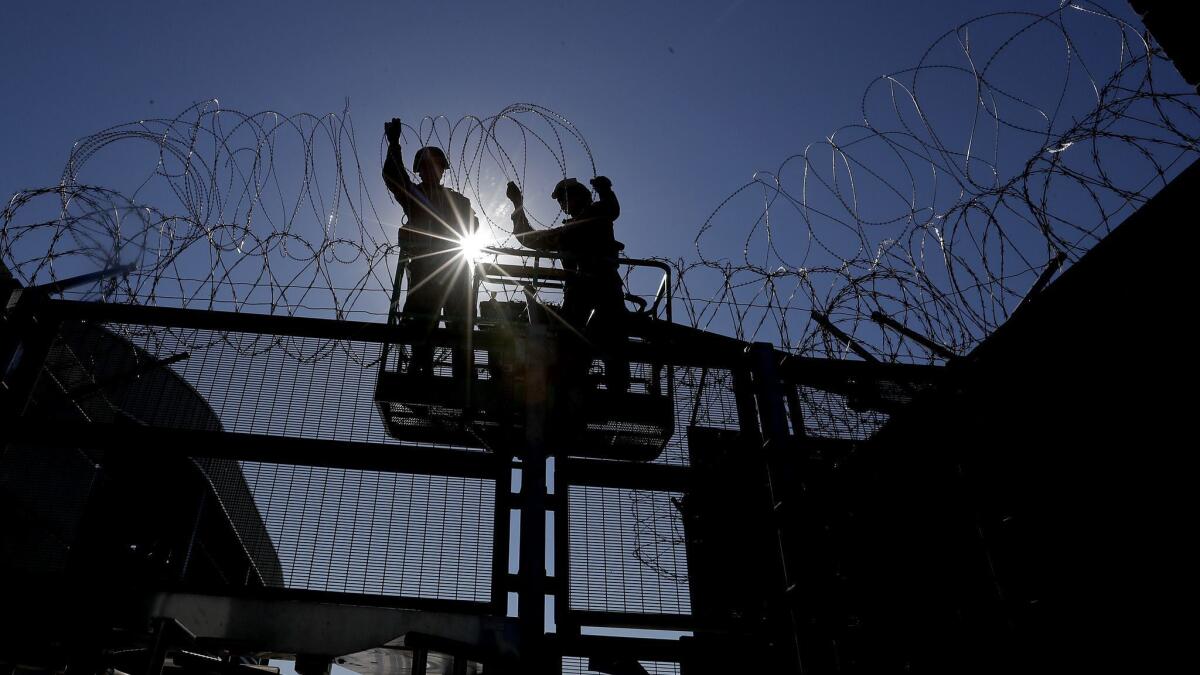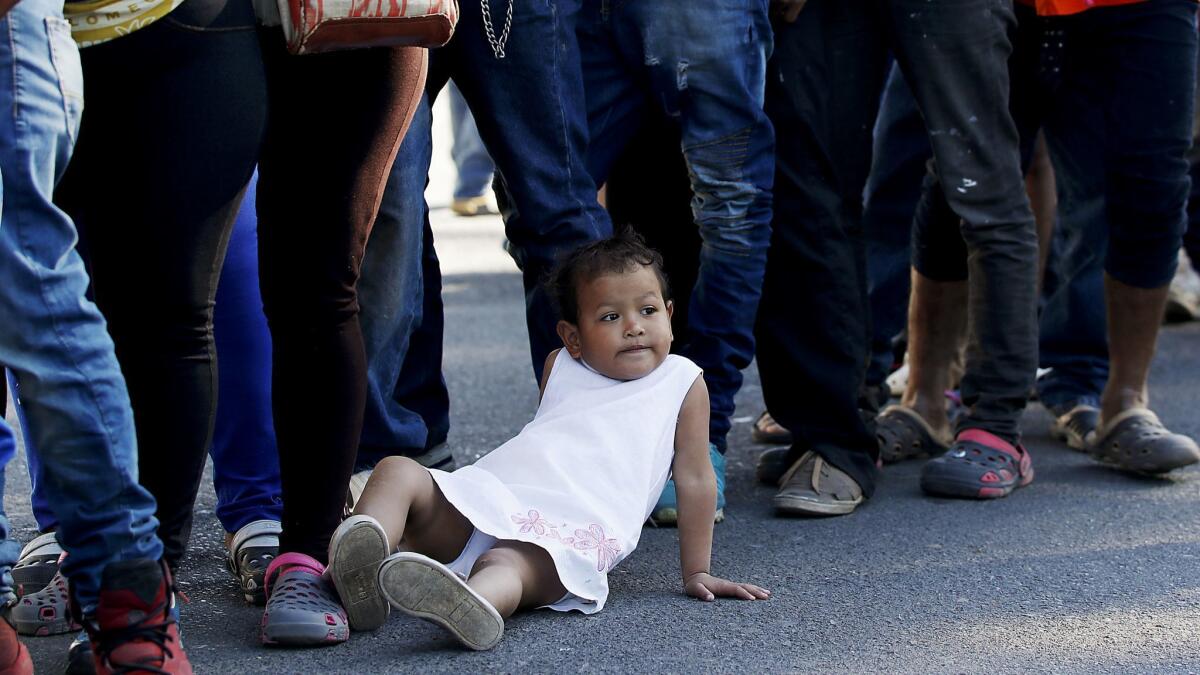Thousands of Hondurans are arriving on the doorstep of the U.S. But they may never get in.

Reporting from Tijuana — He ran a produce stand back in Honduras, but Richard Umanzor said he’s willing to take any work available — in whatever country that will grant him entry.
He and more than 2,000 other migrants who have arrived in this border city in the last few days can see California with their own eyes. But they are starting to realize they may never get there.
“We all came here looking to go to the United States, but now we can see how complicated that is,” Umanzor, 26, said as others nodded in agreement Friday at a sports complex-turned-migrant camp a block away from the steel border fence. “If we can’t go to the United States, why not Canada? Europe? Wherever we can find dignified work.”
Thousands more migrants — members of caravans that began leaving Honduras weeks ago — are expected to pour into Tijuana in coming days and weeks, with no place to go.
The city of 1.6 million was caught off guard by the sudden influx, raising concerns from officials and residents about how they will accommodate the newcomers. The handful of shelters here normally house no more than 100 people each.
In an interview with the Milenio news outlet, Tijuana Mayor Juan Manuel Gastelum said the migrants arriving included a significant criminal element and represented a major burden to the city.
“We don’t want them bothering [our] citizens,” said Gastelum, who added that he was considering holding a referendum to help decide the future of the migrants. “Tijuana is a city of migrants, but not in this way.”
The migrants could be stuck here for months, said Genaro Lopez Moreno, a municipal delegate for downtown Tijuana who was helping coordinate aid.
“No city in the world can handle the arrival of so many people at once without help,” he said. “We are trying our best, but this is a lot to handle all at once.”
Tijuana officials were seeking aid from the central government in Mexico City.

The migrants are hungry and fatigued after traveling roughly 3,000 miles. Now that they are so close to the U.S. border, they are trying to figure out their next move.
As of Friday, there was no concerted effort to file applications for political asylum in the United States. The Trump administration has warned that applicants will probably face long waits in detention and little chance of gaining legal residence.
The sense of exhilaration at having finally reached the border appears to be quickly fading for a group that managed to enter Mexico illegally with relative ease a few weeks ago, getting rides on makeshift rafts across the river from Guatemala.
The U.S. border is far more imposing. Border Patrol agents in vehicles, on horseback and on foot peer southward through their binoculars. Layers of fencing wind up and down the hills east and west of the official crossings. Coils of razor wire line the fence tops.
“A lot of them thought this was going to be something like the border between Mexico and Guatemala,” Lopez Moreno said. “Now they are realizing it’s something quite different.”
Caravan organizers held a kind of pep rally Friday at the sports facility, urging migrants to keep up their spirits.
“Don’t get frustrated!” Irineo Mujica of the migrant advocacy group Pueblo Sin Fronteras urged an assembly held on a soccer field. “We need to think beyond the United States.”
The migrants cheered “Si!” as he asked them whether they would consider relocating to Canada, Germany, France, or elsewhere in Europe — or even remaining in Tijuana and working in its many assembly plants. There was fanciful talk of possible visas and work permits.
“There are many possibilities,” said Mujica, though he conceded in an interview outside the camp that no visas anywhere were guaranteed at this point.
“We’re working on it,” he said.

Later, several evangelical pastors asked the migrants to join in prayer for a successful finale to their voyage.
For weeks, as the migrants progressed through sweltering tropics, rugged mountains and endless expanses of desert, their destination was always clear — the border, gateway to the abundant opportunities so many had heard about in the United States.
Many Mexican families in Tijuana have donated food and expressed solidarity with the migrants.
But not everybody is the city has been so welcoming.
In the upscale Playas de Tijuana neighborhood, residents objected to migrants congregating along the beach, resulting in scuffles and police intervention.
Many wound up at the sports center, where more than 2,000 migrants spent Thursday night. But no one in the group seems to know what the next move will be.
“We are here now, and we still want to go to the United States,” said Rosa Perez, a 30-year-old single mother who made the trip with her four children. “But how we will cross, I don’t know.”
She was cheered by smiles from her 5-month-old son, Esteven, who had been hospitalized with pneumonia in the Mexican city of Guadalajara. While Esteven sat in his stroller, her other children played on swings.

Perez said she would not be a burden in the United States or wherever she ended up. Like others, she said that returning to impoverished and crime-ridden Honduras was not an option.
“My older kids can go to school, and I can take care of the youngest and work part time, maybe cleaning houses,” she said.
Groups of migrants were still arriving Friday on foot and on buses, exhausted after so many weeks of travel. And, deep in Mexico, several other caravans are headed north.
Some migrants at the sports complex were already seeking work locally.
On a basketball court where scores of migrants were sleeping on mats, three young friends filled out generic job applications purchased at a stationery shop. That they didn’t have work papers for Mexico didn’t seem to deter them.
Israel Ramirez, 24, said he was a farmer back home but was ready to work in restaurants, factories or wherever he could earn a living.
“If we can’t get into the United States, maybe we can find work here in Mexico,” he said. “That’s still better than going back to Honduras.”
Times staff writer Andrea Castillo in San Diego and special correspondents Cecilia Sanchez in Mexico City and Liliana Nieto del Rio in Tijuana contributed to this report.
Twitter: @PmcdonnellLAT
UPDATES:
4:50 p.m.: This article was updated throughout with staff reporting.
This article was originally published at 9:45 a.m.
More to Read
Sign up for Essential California
The most important California stories and recommendations in your inbox every morning.
You may occasionally receive promotional content from the Los Angeles Times.










